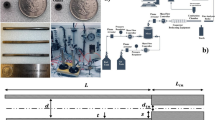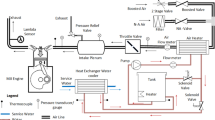Abstract
In this paper, a homogeneous lean combustion concept for gasoline engines with direct injection, small displacement and turbocharging is investigated under high-load conditions. A representative operating point was selected for this purpose. The tests were carried out on a single-cylinder research engine. In particular, the influence of the center of combustion, charge motion and pressure ratio is discussed. It has been discovered that the center of combustion has a large influence on the stability of homogeneous lean combustion at high load points. The present investigations provide a method of how to achieve an early center of combustion in knock-limited load points of homogeneous lean combustion. Early centers of combustion enable a high air–fuel ratio with good, smooth running and low NOx emissions. In addition to the high charge motion, operation with a positive scavenging gradient and valve overlap can be applied to flush the hot internal residual gas out of the combustion chamber, whereby knocking can be reduced. With the high air–fuel ratio, specific fuel consumption can be reduced substantially and high combustion efficiency can be achieved. The results can be leveraged as a basis for future developments in gasoline engines.





Similar content being viewed by others
Notes
The tumble number describes the angular velocity of the charge motion \({\upomega }_{{\text{T}}}\) to the angular velocity of the crankshaft \({\upomega }_{{\text{C}}}\): \({{T} = \text{ }}\frac{{{\upomega }_{{\text{T}}} { }}}{{{\upomega }_{{\text{C}}} }}\). The angular velocity of the charge motion \({\upomega }_{{\text{T}}}\) can be calculated via CFD analysis [12].
Abbreviations
- λ :
-
Air–fuel equivalence ratio of combustion
- N :
-
Engine speed
- η :
-
Efficiency
- p :
-
Pressure
- T :
-
Tumble number
- ω :
-
Angular velocity
- ATDC:
-
After top dead center
- AVT:
-
Active valve train
- bp:
-
Best point
- BTDC:
-
Before top dead center
- CAD:
-
Crank angle degrees
- CEI:
-
Controlled electronic ignition
- CFD:
-
Computational fluid dynamics
- CO2 :
-
Carbon dioxide
- COV:
-
Coefficient of variance
- EVC:
-
Exhaust valve closing
- IMEP:
-
Indicated mean effective pressure
- ISFC:
-
Indicated specific fuel consumption
- IVO:
-
Intake valve opening
- L:
-
Liter
- MFB05:
-
05% Mass fraction burned
- MFB50:
-
50% Mass fraction burned
- MFB90:
-
90% Mass fraction burned
- NOx:
-
Nitrogen oxides
- SCR:
-
Selective catalytic reduction
- WLTC:
-
Worldwide harmonized light duty test cycle
- C:
-
Crankshaft
- Exh.:
-
Exhaust
- i:
-
Indicated
- Int.:
-
Intake
References
Brandt, M.; Hettinger, A.; Schneider, A.; Senftleben, H.; Skowronek, T.: Extension of operating window for modern combustion system by high performance ignition. In: 3. Internationale Tagung Zündsysteme für Ottomotoren, Berlin (2016)
Brinkert, N., Rott, M., Friedrich, J., Weber, S., Freisinger, N., Karl, G.: Konsequente Weiterentwicklung von Stoß-/Stauaufladung am 4-Zylinder Ottomotor. In: 19. Aufladetechnische Konferenz, Dresden (2014)
Heywood, J.B.: Internal Combustion Engines Fundamentals. McGraw-Hill Book Company, New York (1989). (ISBN 0-07-100499-8)
Junker, H.K.: Ein wesentliches Thema bleibt das Downsizing. In: Motortechnische Zeitschrift, 75. Jahrg., 05/2014, S. 22–24
Koch, T.: Verbrennungsmotorenforschung für Antriebe von morgen. In: Automobiltechnischer Zeitschrift extra, Sonderheft für die VDI-FVT 2018/2019, S. 10–12
Lotus Engineering: AVT Active Valve Train—General information and installation, Band edition 18 (2014)
Merker, G.P., Teichmann, R. (eds.): Grundlagen Verbrennungsmotoren, 7th edn. Springer, New York (2014). (ISBN 978-3-658-03194-7)
Motor Presse Stuttgart GmbH & Co.KG, Quelle: https://www.auto-motor-und-sport.de/verkehr/eu-staaten-einigen-sich-auf-schaerfere-co2-grenzwerte/. Accessed 03 Jan 2019
Müller, J., Ritzinger, J., Jost, R., Naunheim, D., Kropp, M.: Einsatz eines Abgasturboladers mit variabler Turbinengeometrie zur Optimierung des ottomotorischen Gemsamtkonzeptes, In: 8. MTZ-Fachtagung “Ladungswechsel im Verbrennungsmotor“ (2015)
Ohler, S.: Entwicklung und Vergleich von Kriterien zur Erkennung der klopfenden Verbrennung in Ottomotoren, Dissertation, Universität der Bundeswehr Hamburg (2014)
Osbourne, R., Lane, A., Turner, N., McWilliam, L., Hinton, N., McAllister, M., Geddes, J., Gidney, J., Cleeton, J., Atkins, P, Morgan, R.: A new-generation lean gasoline engine for reduced CO2 in an electrified world. In: 40. Internationales Wiener Motorensymposium, Wien (2019)
Pischinger, R., Klell, M., Sams, T.: Thermodynamik der Verbrennungskraftmaschine, 3rd edn. Springer, New York (2009). (ISBN 978-3211-99276-0 3)
Rurik, A: Verfahren zum Betreiben einer Verbrennungskraftmaschine; Offenlegungsschrift DE102018003959A1, Deutsches Patentamt (2019)
Schilling, M.: Betriebsstrategien zur Emissionsreduzierung beim Ottomotor mit strahlgeführtem Brennverfahren, Dissertation, Karlsruher Institut für Technologie (KIT) (2012)
Siekmann, H.E., Thamsen, P.U.: Strömungslehre, 2nd edn. Springer, New York (2000). (ISBN 978-3-540-73726-1)
VDI Nachrichten: Mazda mag es mager, Quelle. https://www.vdi-nachrichten.com/technik/mazda-mag-es-mager. Accessed 19 Oct 2019
Zeldovich, Y.B.: The oxidation of nitrogen in combustion and explosions. In: Acta Physicochimica, URSS 21, Heft 4, S. 577–628 (1946)
Author information
Authors and Affiliations
Corresponding author
Ethics declarations
Conflict of interest
On behalf of all authors, the corresponding author states that there is no conflict of interest.
Additional information
Publisher's Note
Springer Nature remains neutral with regard to jurisdictional claims in published maps and institutional affiliations.
Rights and permissions
About this article
Cite this article
Rurik, A., Otto, F. & Koch, T. Strategy and potential of homogeneous lean combustion at high load points for turbocharged gasoline engines with direct injection and small displacement. Automot. Engine Technol. 5, 71–77 (2020). https://doi.org/10.1007/s41104-020-00061-2
Received:
Accepted:
Published:
Issue Date:
DOI: https://doi.org/10.1007/s41104-020-00061-2




